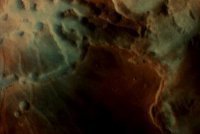New traces of life found on Mars
 Catherine Weitz and her colleagues from the Institute of Planetology (USA) have discovered yet another proof that there could have been life on Mars at some point. This conclusion was made based on the information obtained by interplanetary station NASA Mars Reconnaissance Orbiter. The researchers are talking about two depressions 30-40 km long, located in the region of Noctis Labyrinthus ("the labyrinth of the night").
Catherine Weitz and her colleagues from the Institute of Planetology (USA) have discovered yet another proof that there could have been life on Mars at some point. This conclusion was made based on the information obtained by interplanetary station NASA Mars Reconnaissance Orbiter. The researchers are talking about two depressions 30-40 km long, located in the region of Noctis Labyrinthus ("the labyrinth of the night").
These depressions contain a type of clay called smectites, which contains a blend of silica with aluminum, iron or magnesium. This is a group of hydrous silicates formed by weathering of mainly alumina-silicates and silicates of igneous and metamorphic rocks on the soil surface. These rocks are formed in the water with neutral acidity.
In addition, in the nearby Tharsis region the largest extinct volcanoes in the solar system are located, including Mount Olympus, Mount Askriyskaya, Mountain Peacock, Mount Arsiya and, finally, a unique volcano Alba. According to the researchers, as a result of magma outflow there must have been a release of carbon dioxide and water vapor in the amount that would be sufficient for the formation of atmospheric pressure of 1.5 bars and the water layer with thickness of 150 meters. Consequently, we can say that there is hydrothermal activity in these areas. This once again confirms the hypothesis that early in its history, the planet was wet and warm.
According to the scientists, in contrast to other regions of Mars with the content of iron-magnesium smectites whose occurrence belongs to the so-called Noah period (over 3.7 billion years ago), the age of the studied deposits is only two or three billion years, which means that they were formed at the present stage of geological history of Mars, in the era of Amazon. Consequently, relatively recently they might have been life there, at least in its simplest form.
In addition, several mysterious wells have been discovered at Tharsis. Their depth is estimated to be no less than 178 meters. Scientists suggest that these voids were burned under the surface of the hot volcanic lava. Sharp edges of the wells speak about their geological youth.
Unfortunately, this region cannot be studied using rovers due to the lack of available equipment and complexity of the relief, unsafe for landing and movement. However, the current Mars Rover "Opportunity" recently discovered similar conditions favorable for the emergence of micro-organisms in the vicinity of Endeavour crater.
Unfortunately, there is more than enough evidence of "life on Mars", and most of it is based solely on visual effects. Some photographs on the Martian surface display a "face of the Sphinx", some show a human figure, or even something similar to city ruins. There are also stories of "Mars canals" that allegedly indicate the presence of artificial water reservoirs on the Red Planet. Unfortunately, there were no archaeological artifacts and bodies of water on the deserted planet.
However, last year, researchers from Germany found tracks similar to canals on the slopes of a Martian canyon in the region of Melas Chasma. On the bottom of the canals sulfate compounds were discovered that are usually formed as a result of oxidation caused by water. This led to the conclusion that there was once a large sea there.
Back in 2006, MARSIS radar discovered vast accumulation of ice beneath the surface of the planet, and not only at the poles. In particular, a crater with a diameter of approximately 250 kilometers located under Chryse plain is filled with ice.
Scientists believe that over time there was water on Mars not only in a frozen, but also liquid form. Volcanoes melted the ice below the surface and the water flowed out. Sometime later it began to evaporate, as evidenced by sulfates compounds found on the planet.
A group of geologists and biologists of the SETI Institute and NASA Ames Research Center, while studying the images from Mars drew attention to the mysterious dark streaks on the slopes of Martian hills, which, according to the scientists, may represent flows of salt water. This environment is favorable for reproduction of halobacteria. Therefore, there is still hope that there is life on our nearest red planet.
Irina Shlionskaya
Pravda.Ru
Subscribe to Pravda.Ru Telegram channel, Facebook, RSS!




